
Who would have thought that a play written well over four hundred years ago by a contemporary of William Shakespeare would be in-your-face gay enough to make it an appropriate choice for an LGBT theater season?
Darcy Hogan obviously thought so when she set about adapting Christopher Marlowe’s Edward II (aka The Troublesome Reign And Lamentable Death Of Edward The Second, King Of England, With The Tragical Fall Of Proud Mortimer) for Theatre Out’s 2010 season.
In the interest of full disclosure, big chunks of dialog are Hogan’s and not Marlowe’s. At the same time, they are so seamlessly integrated into the original playwright’s script that I could not tell you where one ended and the other began. My guess is that the frequent man-on-man snogging (check your British slang dictionary) in the Hogan-directed production is entirely a recent development. Regardless, for classical theater lovers, Marlowe is the next best thing to Shakespeare (coincidentally both were born in 1564, exactly two months apart to the day), and there is no better Elizabethan play than Edward II for audiences who prefer their love stories to be of the same gender variety.
As to the question of whether Hogan’s gay Citizen Kane (she conceived, adapted, directed, scenic designed andcostume designed the Theatre Out production) succeeds artistically and as a crowd pleaser, the answer to both is a mostly unqualified yes.
Ben Green is Edward II, King of England from 1307 to 1327, and Angel Correa is Gaveston, his male lover and a thorn in Queen Isabella’s side. No wonder Her Majesty (Katherine Curci (Prevonost)) conspires with Mortimer (Gregory Spradlin), a member of Edward’s court, to get rid of her competition. Anyone familiar with English history knows not to expect a happy ending, especially where for one of the two lovers at least, the entirely unhappy ending comes via a red hot poker to a particularly unfortunate rear end. Still there is ample romance, much of it expressed lip-to-lip, to please LGBT audience members and their straight but not narrow counterparts.
In the title role, Green equals his recent superb performance in Bent with powerful, committed work as the doomed monarch. In fact, watching Green on stage is akin to witnessing a young Sean Penn at the start of his career—a performance with much of the intensity that Penn brings to his work and an absolute ease with iambic pentameter. Opposite Green, the dashing Spradlin (his costar in Bent) does outstanding work as the dastardly Mortimer, and in fact this combination of dashing and dastardly is a significant factor in what makes Spradlin’s performance work so well. Both actors stand out for their ability to make Marlowe sound absolutely contemporary, all the while respecting the cadences of the Elizabethan original.
There are really no weak links among supporting players, though occasionally the color/age/type-blind casting can be disconcerting. Queen Isabella and Edward’s younger brother Edmund appear each to be a decade or two older than Green, and Gaveston is not played by the kind of young Leonardo De Caprio/Jude Law-type the part would seem to call for. I wonder too if casting female actors in male roles is appropriate in this particular play, given that so much of Edward II’s drama revolves around the gender of his “minion.” Still, kudos are in order for the entire cast, whose work is fully “on the same page” as Green’s and Spradlin’s.
Curci (Prenovost) is a beauteous, elegant Isabella and Kevin Cordova does sturdy work as Edmund. Correa gives a lovely, touching performance as Gaveston, and there is considerable chemistry between him and Green in their romantic scenes. Rob’n Lewis is particularly strong as the Archbishop Of Canturbury et al. Completing the cast are Lauren Kushin and Jamie Sowers, both doing fine work in a variety of roles.
Hogan’s scenic and costume design have just the right period feel and elegance, all the while adhering to what must be a limited budget. Both are made to look all the better thanks to Christina L. Munich’s superb lighting design. Hogan’s direction (and what I assume must be her sound/music design) keeps the play moves swiftly and virtually seamlessly from scene to scene (there are twenty-five in all). David C. Carnevale is production stage manager and Spradlin fight choreographer.
I approached Edward II with a healthy bit of skepticism. Would the plot and language be easy enough to follow? Would the performers be able to adjust their 21st Century acting to 16th Century dialog? Would Hogan’s concept work?
It took very little time for my doubts to be allayed. This is a strong production, worth seeing if only for Green’s and Spradlin’s work, and hey, a little gay English history thrown in for good measure doesn’t hurt. All in all, Theatre Out’s production of Edward II makes for an entertaining and enlightening evening of LGBT theater.
Theatre Out, The Empire Theatre, 202 N. Broadway, Santa Ana.
www.theatreout.com
–Steven Stanley
May 14, 2010
Photos: Darcy Hogan

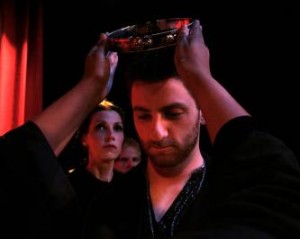
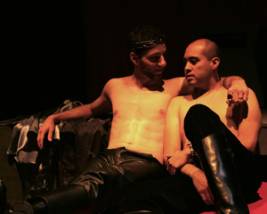
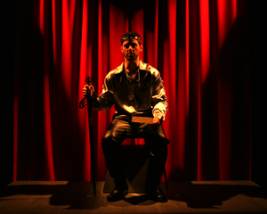
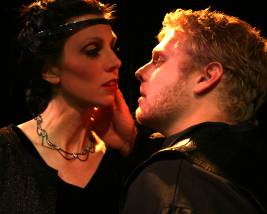
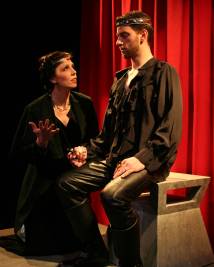

 Since 2007, Steven Stanley's StageSceneLA.com has spotlighted the best in Southern California theater via reviews, interviews, and its annual StageSceneLA Scenies.
Since 2007, Steven Stanley's StageSceneLA.com has spotlighted the best in Southern California theater via reviews, interviews, and its annual StageSceneLA Scenies.







 COPYRIGHT 2024 STEVEN STANLEY :: DESIGN BY
COPYRIGHT 2024 STEVEN STANLEY :: DESIGN BY